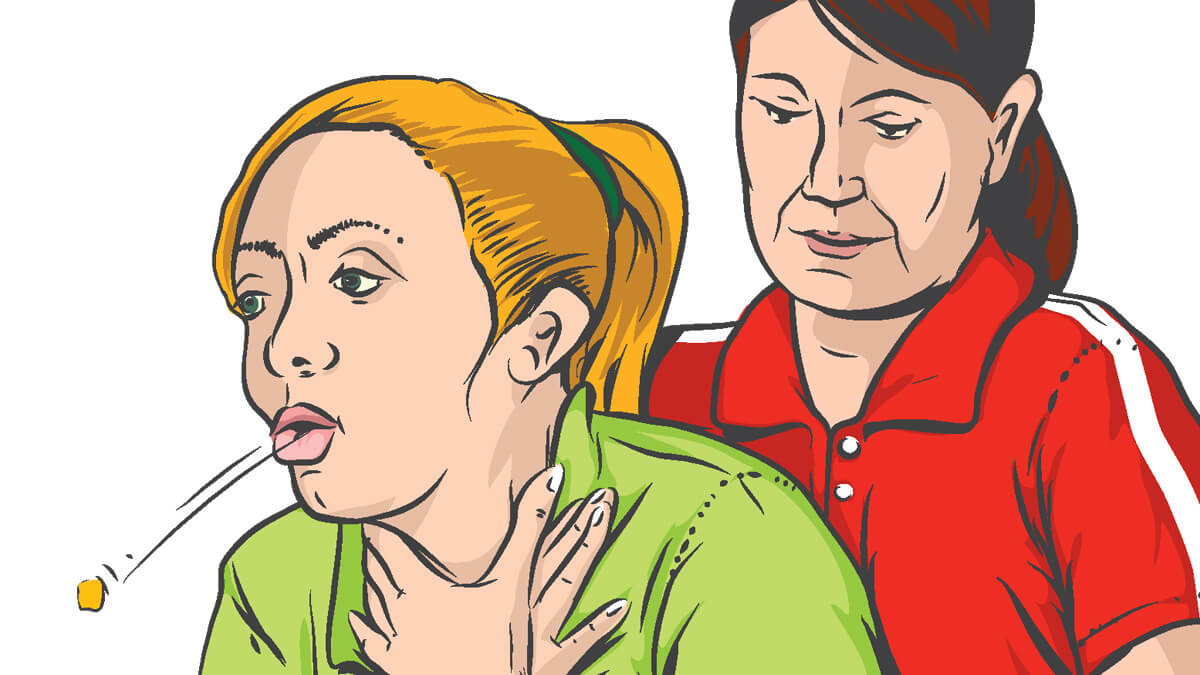What is choking?
Choking is when food or another foreign object becomes stuck in the airway. Choking prevents oxygen from getting to the lungs and the brain.
Signs of someone choking:
- A person is not coughing.
- A person is unable to speak or breathe.
- A person is signaling for help, typically by holding their hands around their throat.
- A person is making squeaky sounds.
- The person’s skin, lips or nails are turning blue or flushed.
Fast Facts:
- Lack of oxygen to the brain for more than four minutes may cause brain damage or death.
- In 2019, there were around 5,228 choking deaths in the United States.
- Death involving food is more common among the elderly.
- Choking is the fourth leading cause of unintentional death.
- The odds are 1 in 2,535 of dying from choking on food.
- The Heimlich maneuver was invented by Henry Judah Heimlich, a thoracic surgeon born in 1920.
- The Heimlich maneuver is often referred to as the abdominal thrust.
Prevent choking in adults by following these precautionary measures:
- Cut food into small pieces.
- Chew food slowly and thoroughly, especially if you are wearing dentures.
- Avoid laughing and talking while chewing and swallowing.
- Avoid excessive intake of alcohol before and during meals.
Prevent choking in children by following these precautionary measures:
- Keep marbles, thumbtacks, latex balloons, coins and other small toys and objects out of reach.
- Prevent children from running, walking or playing when they have food or toys in their mouth.
- Children under 4 years of age should avoid foods such as hot dogs, nuts, chunks of meat or cheese, grapes, hard or sticky candy, popcorn, chunks of peanut butter or raw carrots.
- Supervise mealtimes.
- Prevent older siblings from giving a dangerous food or toy to a young child.
How to perform the Heimlich maneuver:
- Reach around the person’s waist.
- Position your clinched fist above the navel and below the rib cage.
- Grasp your fist with your other hand. Pull the clenched fist sharply and directly backward and upward under the rib cage six to 10 times quickly.
- If the person is obese or in late pregnancy, give chest compressions.
- Continue uninterrupted until the obstruction is relieved or advanced life support is available. In either case, the person should be examined by a health care professional as soon as possible.
- If you are by yourself, you can utilize the back of a chair and thrust against it below your rib cage to try and dislodge the obstruction.
How to perform the Heimlich maneuver for infants younger than 1:
- Take a seated position and hold the infant face down on your forearm, which is resting on your thigh.
- Support the infant’s head and neck with your hand, and place the head lower than the trunk.
- Use the heal of your hand to thump the infant gently but firmly five times in the middle of the back. The combination of gravity and the back blows should release the blocking object. Keep your fingers pointed up to avoid hitting the infant in the back of the head.
- Turn the infant face up on your forearm, resting on your thigh with the head lower than the trunk if the infant still isn’t breathing. Using two fingers placed at the center of the infant’s breastbone, give five quick chest compressions. Press down about 1½ inches, and let the chest rise again between each compression.
- Repeat the back blows and chest thrusts if breathing doesn’t resume. Dial 911 and call for emergency help.
- Begin infant CPR if one of these techniques opens the airway but the infant doesn’t resume breathing.
- If the child is older than 1 and conscious, give abdominal thrusts only. Always be careful not to use too much force to avoid damaging ribs or internal organs.
- If a child is unconscious, call 911. If someone else is present, have them call 911 while you perform these maneuvers.
The most common mistake when a person is choking is to slap them on the back. If you do, gravity may cause the object to slip further down the trachea.
While the American Heart Association does not teach the back blow technique, CPR guides and the American Heart Association recommend a “five-and-five” approach to delivering first aid when a person is able to cough forcefully. It’s OK not to use this technique; both approaches are acceptable.
Give five back blows while standing to the side and just behind a choking adult. For a child, kneel down behind. Place one arm across the person’s chest for support. Bend the person over at the waist so that the upper body is parallel with the ground. Deliver five separate back blows with the heel of your hand between the person’s shoulder blades.
Give five abdominal thrusts – the Heimlich maneuver.
Alternate between five blows and five thrusts until the blockage is dislodged.
Choking also can be an issue for pets such as dogs and cats. Most dogs will chew nearly anything: bones, toys, shoes and socks, while cats tend toward small items such as a pen cap, a bell or a thimble. Rubber balls, chew toys, sticks or acorns can all become swollen due to moisture.
Signs of a choking pet can be: pawing at the mouth; drooling, coughing or gagging; anxiety or panic; labored breathing; fainting or unconsciousness; or bad breath or loss of appetite. While maneuvers are similar for larger dogs as with humans, smaller dogs and cats it are slightly different. Be sure to familiarize yourself with the techniques suggested by your veterinarian.
Information collected by Stacy Domingo
Sources: HopkinsMedicine.org, MayoClinic.org, Statista.com, FirstAidKitSurvival.com, PetMD and NSC.org
